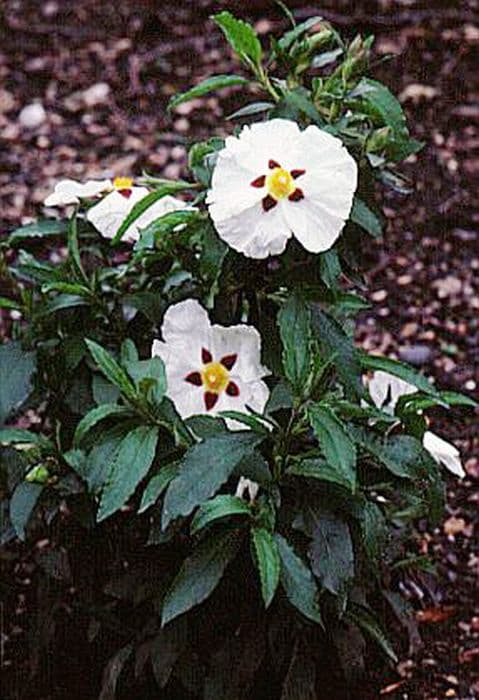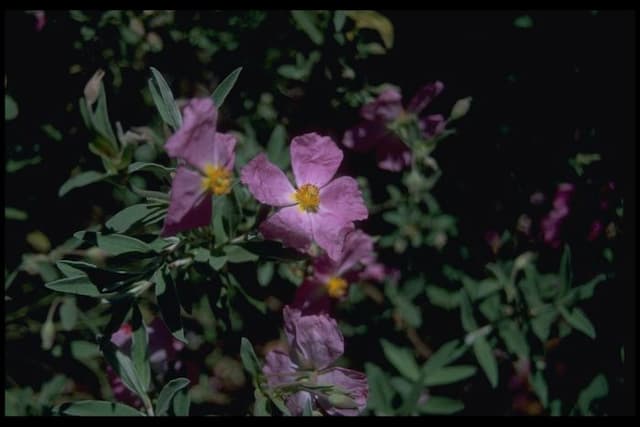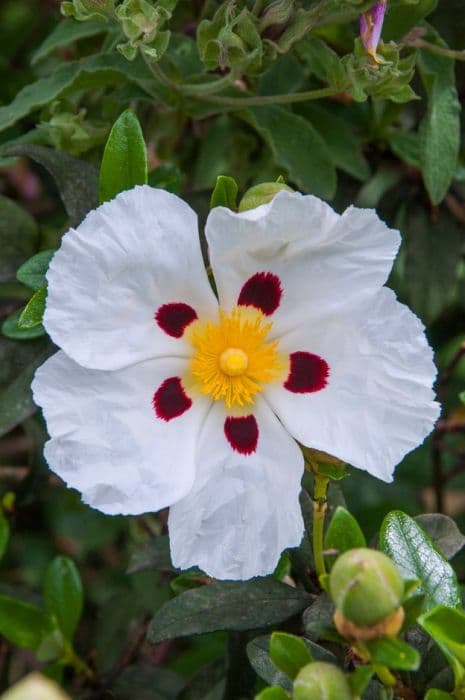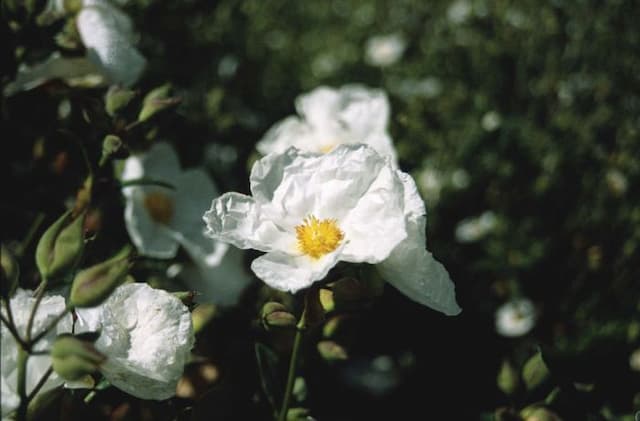Rock Rose Helianthemum 'Beech Park Red'

ABOUT
The Helianthemum 'Beech Park Red', commonly known as the Rock Rose 'Beech Park Red', is characteristically known for its vibrant and showy floral display. The plant sports plush evergreen foliage that often serves as a lush backdrop for the radiant flowers. The leaves are small, often narrow, and may exhibit a grayish-green hue, contributing to a subdued texture that complements the blossoming elements of the plant. The most striking feature of the Rock Rose 'Beech Park Red' is its flowers. The blooms boast a rich red color, with a boldness that can act as a focal point in any garden setting. Each flower typically has five delicate petals that may appear slightly wrinkled or crumpled, adding to the plant's rustic charm. The centers of the flowers usually have a contrasting hue, often yellow, due to the presence of stamens, which can attract various pollinators. The Rock Rose 'Beech Park Red' exudes a wildflower-like elegance, with its flowers sprouting in abundance during the blooming season, creating a striking contrast against the green foliage. The overall appearance of the plant is one of hardiness and natural beauty, making it a popular choice for gardeners looking to add a touch of vivid color and Mediterranean flair to their landscapes.
About this plant
 Names
NamesFamily
Cistaceae.
Synonyms
Rock Rose, Sun Rose.
Common names
Helianthemum 'Beech Park Red'.
 Toxicity
ToxicityTo humans
Helianthemum 'Beech Park Red', commonly known as rock rose, is not widely known to be toxic to humans. There is no significant evidence to suggest that rock rose poses any serious risks upon ingestion. However, it is generally advised to avoid eating ornamental plants due to potential individual allergies or sensitivities.
To pets
Rock rose is not generally considered toxic to pets such as dogs and cats. There is no common documentation of toxicity involving the ingestion of rock rose by pets. However, as with any non-food plant, it is still recommended to prevent pets from consuming plant material to avoid the potential for gastrointestinal upset or an unexpected allergic reaction.
 Characteristics
CharacteristicsLife cycle
Perennials
Foliage type
Evergreen
Color of leaves
Green
Flower color
Red
Height
1 foot [30 cm]
Spread
2 feet [60 cm]
Plant type
Shrub
Hardiness zones
5
Native area
Mediterranean
Benefits
 General Benefits
General Benefits- Attracts Pollinators: The vibrant flowers of Rock Rose attract bees and butterflies, enhancing pollination in the garden.
- Drought Tolerant: Once established, Rock Rose is very tolerant of dry conditions, making it suitable for xeriscaping.
- Low Maintenance: Rock Rose requires minimal care once established, needing only occasional watering and very little pruning.
- Erosion Control: Its dense growth habit helps stabilize soil and prevent erosion on slopes and banks.
- Colorful Blooms: Rock Rose provides bright red flowers that add a splash of color to garden beds and borders.
- Sun Tolerance: This plant thrives in full sun, making it ideal for sunny areas where other plants might struggle.
- Ground Cover: The low-growing, spreading nature of Rock Rose makes it an excellent ground cover, filling in spaces and suppressing weeds.
- Wildlife Friendly: Provides habitat and food for wildlife, including beneficial insects and small mammals.
- Adaptable: Rock Rose can adapt to a wide range of soil types, as long as they are well-draining.
- Seasonal Interest: Offers a long flowering season, usually from late spring through summer, providing extended visual interest.
 Medical Properties
Medical PropertiesThis plant is not used for medical purposes.
 Air-purifying Qualities
Air-purifying QualitiesThis plant is not specifically known for air purifying qualities.
 Other Uses
Other Uses- Photography Prop: The vibrant red flowers of Rock Rose can be used as a photography prop to create attractive backdrops or focal points in pictures.
- Educational Model: Rock Rose plants can serve as a live model in botany classes to teach about plant structure and the adaptations of sun-loving plants.
- Erosion Control: Due to its ability to form a dense mat, Rock Rose can be planted on slopes and banks to help prevent soil erosion.
- Natural Food Coloring: The brightly colored petals of Rock Rose could potentially be used to extract natural food colorants for culinary purposes.
- Craft Material: Dried Rock Rose flowers and leaves can be used in making crafts like bookmarks, pressed flower art, and potpourri.
- Artistic Inspiration: The striking appearance of Rock Rose can serve as inspiration for artists and designers seeking vibrant, natural colors for their work.
- Temperature Indicator: Rock Rose flowers close at night and during cloudy, cold weather, which can act informally as a temperature indicator to gardeners.
- Soil Health Indicator: The growth and health of Rock Rose can reflect soil conditions, helping gardeners gauge soil quality and drainage.
- Performance Arts: Leaves and petals of Rock Rose can be used in stage plays and performances as part of costumes or set decoration to represent nature.
- Behavioral Studies: The plant's response to sunlight can be used in experiments related to phototropism and plant behavior in educational settings.
Interesting Facts
 Feng Shui
Feng ShuiThe Rock Rose is not used in Feng Shui practice.
 Zodiac Sign Compitability
Zodiac Sign CompitabilityThe Rock Rose is not used in astrology practice.
 Plant Symbolism
Plant Symbolism- Vitality: The 'Beech Park Red', commonly known as Rock Rose, symbolizes vitality due to its bright and vibrant red flowers that seem to exude energy and life force.
- Survival: Rock Roses are known for their resilience; they can thrive in poor soils and withstand drought, representing the ability to survive and persist through hard times.
- Courage: The robust nature of the Rock Rose, facing the intense sun and dry conditions, is often seen as a symbol of courage to face life's challenges.
- Beauty: The Rock Rose, with its beautiful flowers, represents the concept of natural beauty triumphing over harsh conditions.
- Renewal: As a plant that can come back strong after being affected by adverse conditions, the Rock Rose is also seen as a symbol of renewal and fresh starts.
 Water
WaterRock Rose 'Beech Park Red' prefers a well-draining soil and does not like to be overwatered. During the growing season, water when the top inch of soil feels dry, about once a week depending on weather conditions. However, it's resilient to drought and requires less frequent watering once established, potentially every two weeks if there's no rain. Always avoid soggy conditions as this can lead to root rot. Typically, each watering session should involve around one gallon of water to ensure the root zone is thoroughly moistened.
 Light
LightRock Rose 'Beech Park Red' thrives best in full sunlight. It should be planted in a spot where it receives at least six hours of direct sunlight each day. However, it can also tolerate partial shade, especially in the hotter parts of the day, but flowering is most prolific in full sun.
 Temperature
TemperatureRock Rose 'Beech Park Red' is hardy and can tolerate a range of temperatures. It can survive minimum temperatures down to about 10 degrees Fahrenheit, but ideally, it should be kept in conditions where the temperature ranges between 50 and 75 degrees Fahrenheit for optimal growth and flowering. Hot summer temperatures are typically well-handled by this plant.
 Pruning
PruningPruning Rock Rose 'Beech Park Red' should be done to maintain shape and encourage bushier growth. It's best to prune in early spring, just before new growth begins, to keep the plant compact and to remove any winter-damaged stems. Pruning can also stimulate new blooms. Generally, prune once a year after the risk of frost has passed.
 Cleaning
CleaningAs needed
 Soil
SoilRock Rose 'Beech Park Red' thrives in well-draining soil with a mix of sand, peat, and loam, ideally with a pH of 6.0 to 7.5, ensuring good drainage while retaining adequate moisture.
 Repotting
RepottingRock Rose 'Beech Park Red' should be repotted every 2-3 years or when it becomes root-bound.
 Humidity & Misting
Humidity & MistingRock Rose 'Beech Park Red' prefers a dry to moderate humidity environment and can tolerate arid conditions well.
 Suitable locations
Suitable locationsIndoor
Ensure bright light, good air circulation, and avoid overwatering for indoor Rock Rose.
Outdoor
Plant in sunny spot with well-draining soil and space 12 inches apart.
Hardiness zone
5-9 USDA
 Life cycle
Life cycleThe Rock Rose 'Beech Park Red' starts its life cycle as a seed, typically germinating in favorable conditions of warmth and sunlight. As a seedling, it establishes a small root system and begins to produce its initial leaves. As a young plant, it grows and develops a woody structure, forming a small shrub with gray-green foliage. The Rock Rose reaches maturity when it begins to flower, usually within a year, showcasing its vibrant red blooms that attract pollinators during the growing season. After pollination, the flowers develop into seed pods, which eventually release seeds, continuing the cycle. The plant is perennial, with some Rock Roses living several years, during which it enters a dormancy period in colder months and resumes growth in the spring.
 Propogation
PropogationPropogation time
Spring-Early Summer
Propogation: The Helianthemum 'Beech Park Red', commonly known as Rock Rose, is typically propagated through softwood cuttings. The optimal time for this is in late spring or early summer when new growth is tender and green. To propagate, a gardener would cut a 4 to 6-inch (10 to 15 centimeters) section of stem that has no flowers. It's important to make the cut just below a leaf node, as this is where roots will form. The bottom leaves are removed, and the cutting may be dipped in rooting hormone powder to encourage root growth. Then, the cutting is planted in a mix of perlite and peat moss, maintaining a high level of humidity and warmth until the cutting has rooted, which usually takes about 4 to 6 weeks. Once the roots have formed, the new Rock Rose plant can be transplanted into a more permanent location.









